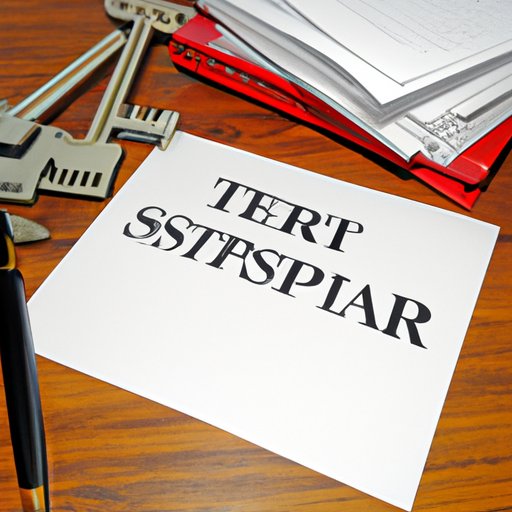Introduction
A restraining order is a court order that legally prohibits someone from engaging in certain activities or coming within a certain distance of another person. Restraining orders are most commonly used in cases of domestic violence but can also be issued in other circumstances, such as stalking or harassment. Filing a restraining order should be taken seriously and it is important to understand the legal process involved in obtaining one.
Step-by-Step Guide to Filing a Restraining Order
The process of filing a restraining order varies by state, so it is best to contact your local courthouse or the state attorney general’s office for specific instructions. Generally, however, the steps involved in filing a restraining order are as follows:
1. Obtain the Necessary Paperwork and Fill it Out Correctly
The first step in filing a restraining order is to obtain the necessary paperwork from your local courthouse. The paperwork will typically include a petition (or complaint) to request the restraining order, a summons (which informs the respondent of the restraining order), and a form to have the respondent served with the papers. Once you have obtained the paperwork, it is important to fill it out correctly and provide all the required information.
2. Include All Required Information in the Petition
Once the paperwork has been retrieved, the petitioner must provide detailed information in the petition regarding the reason they are seeking a restraining order. This information may include the name of the respondent, the type of behavior being restrained, the length of time the order is to remain in effect, and any other relevant details. It is also important to include evidence to support the claim, such as police reports, medical records, or witness statements.
3. Properly Serve the Respondent
Once the paperwork has been filled out correctly, the petitioner must ensure that the respondent is properly served with the papers. This usually involves having a law enforcement officer deliver the paperwork to the respondent. Once the paperwork has been served, the respondent will then have the opportunity to respond to the petition.

How to Get a Restraining Order: What You Need to Know
In order to obtain a restraining order, the petitioner must understand and follow the legal process. This includes filing the paperwork correctly, properly serving the respondent, attending a court hearing, and possibly other steps depending on the state laws. It is important to note that the petitioner does not need to pay for their own lawyer; rather, the court will appoint a lawyer to represent them if they cannot afford one.
It is also important to know the requirements for filing a restraining order in your state. Many states require that the petitioner show evidence of abuse or threat of abuse in order to qualify for a restraining order. Additionally, some states require the petitioner to have a relationship with the respondent, such as being a family member or former partner, while others do not.

An Overview of the Process of Obtaining a Restraining Order
Once the paperwork has been filed, the court will review the petition and decide whether or not to issue a restraining order. If the court decides to issue a restraining order, there are several types of orders that may be issued. These include orders of protection, which prohibit the respondent from contacting or coming near the petitioner; stay away orders, which prohibit the respondent from coming within a certain distance of the petitioner; and gun violence restraining orders, which prohibit the respondent from possessing firearms.
At the restraining order hearing, the petitioner and respondent will both have the opportunity to present evidence and testimony. The judge will then decide whether or not to grant the restraining order, and if so, what type of order to issue and for how long it will remain in effect. The court may also impose additional conditions on the respondent, such as requiring them to attend counseling or to surrender any firearms they possess.
Tips on How to Prepare for a Restraining Order Hearing
Preparing for a restraining order hearing can be stressful, but it is important to take the time to gather evidence and prepare testimony to support your case. Evidence can include photographs, police reports, medical records, text messages, emails, or anything else that supports the claim. It is also important to practice testifying and to familiarize yourself with the legal process.
Additionally, it is important to remember that the restraining order hearing is an opportunity for the respondent to tell their side of the story. The respondent may have witnesses, evidence, or testimony that could impact the outcome of the hearing, so it is important to be prepared for any potential arguments or challenges.

Resources to Help When Filing a Restraining Order
When filing a restraining order, it is important to be aware of the resources available to help. Most states have organizations that provide assistance to victims of domestic violence or stalking, such as the National Domestic Violence Hotline (800-799-7233) or the Stalking Resource Center (888-818-4673). Additionally, many legal aid organizations offer free or low-cost legal services to those who cannot afford an attorney.
It is also important to remember that filing a restraining order is a serious process and should not be taken lightly. If you are considering filing a restraining order, it is important to seek professional help and to understand the legal process involved.
Conclusion
Filing a restraining order is a complex legal process that requires careful preparation and understanding of the law. By following the steps outlined in this article, such as obtaining the necessary paperwork, filling it out correctly, and gathering evidence to support the case, petitioners can be better prepared to obtain a restraining order. Additionally, there are many resources available to help those considering filing a restraining order, including legal aid organizations, support groups, and hotlines.
(Note: Is this article not meeting your expectations? Do you have knowledge or insights to share? Unlock new opportunities and expand your reach by joining our authors team. Click Registration to join us and share your expertise with our readers.)
